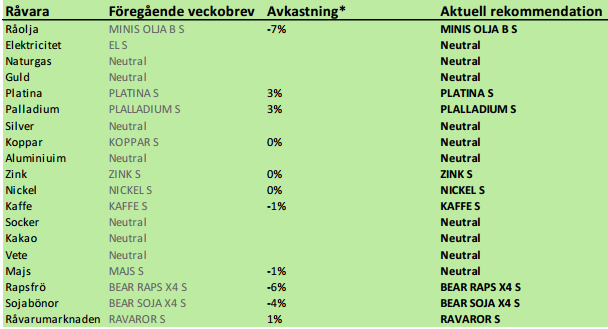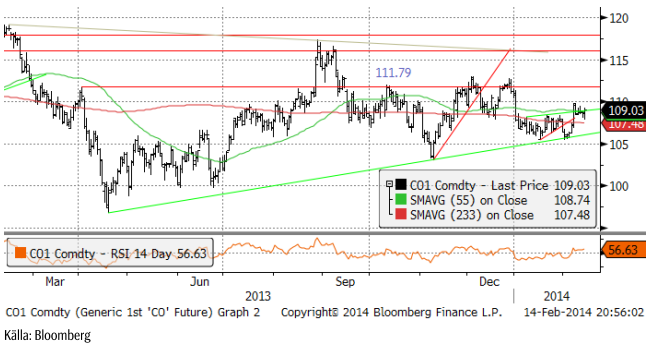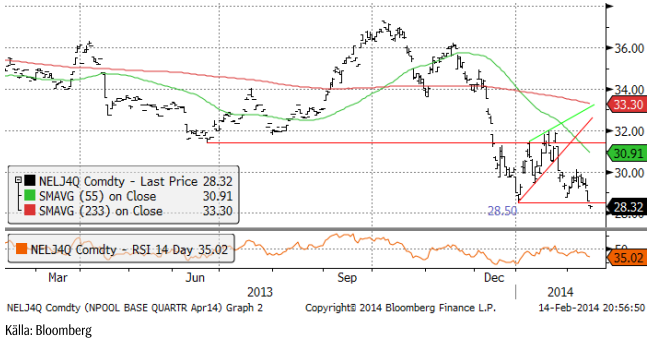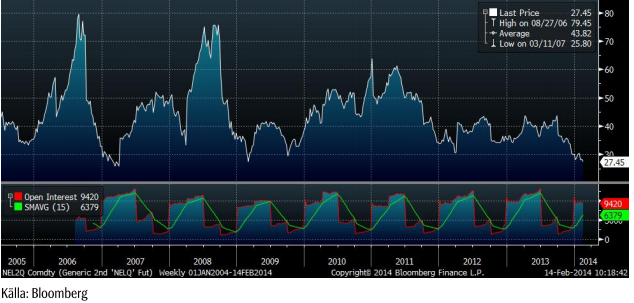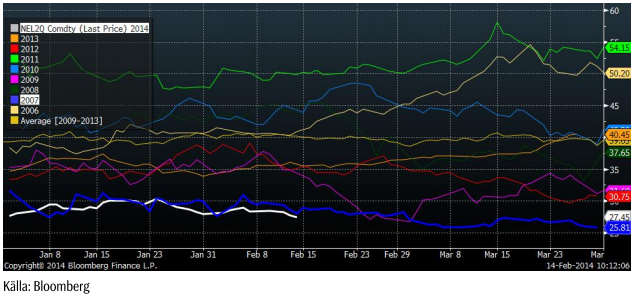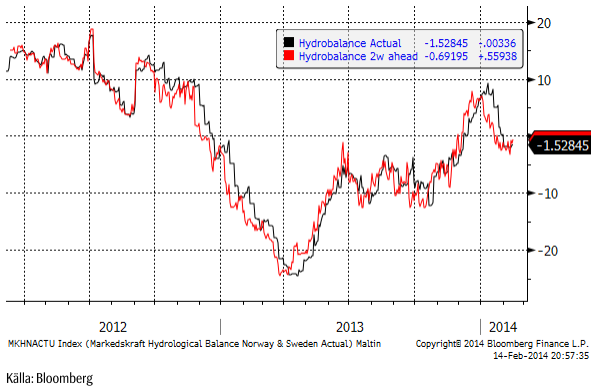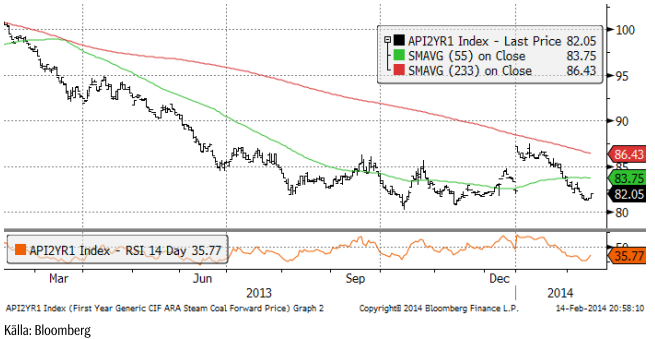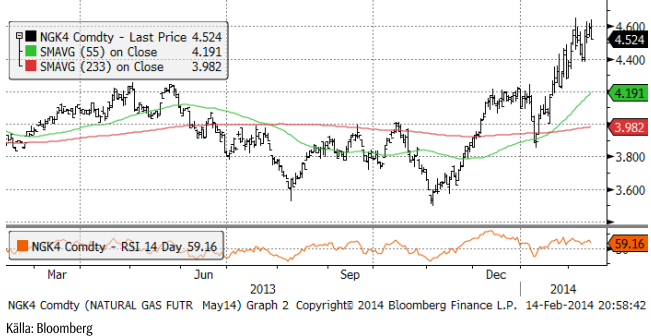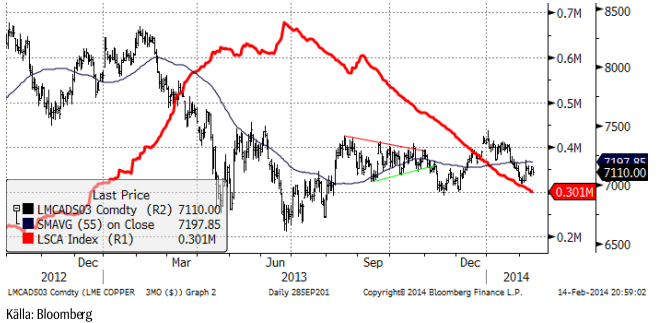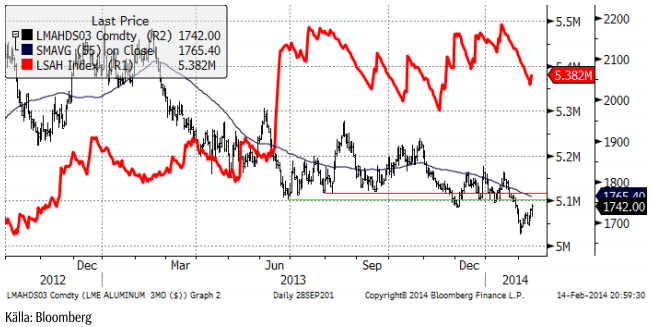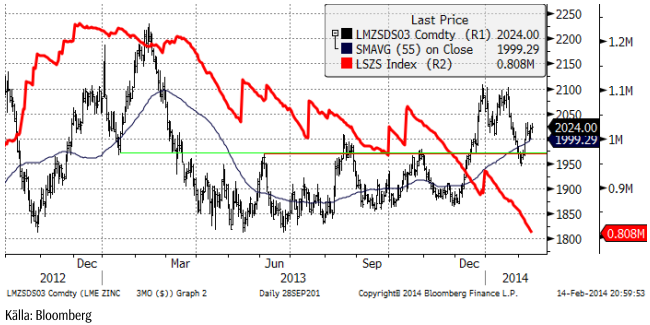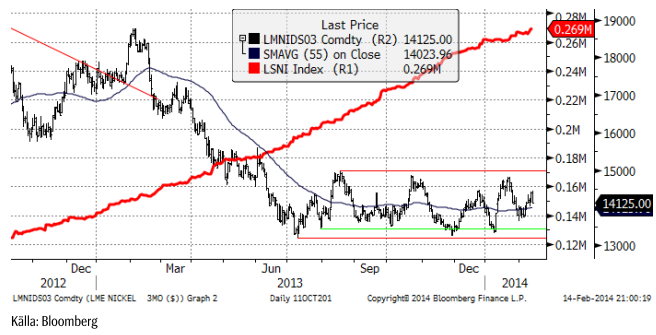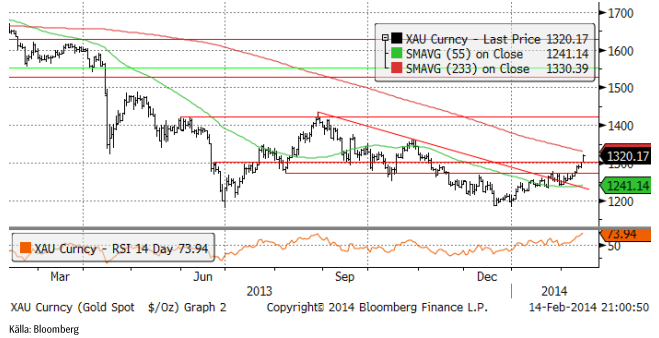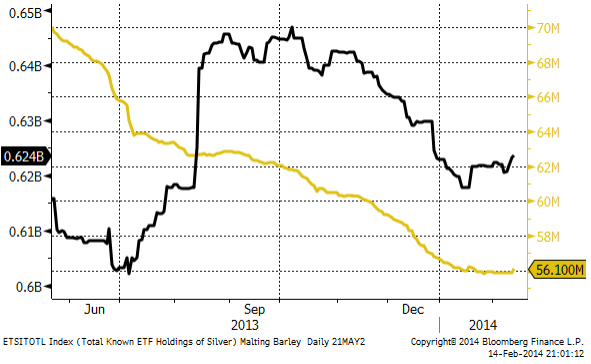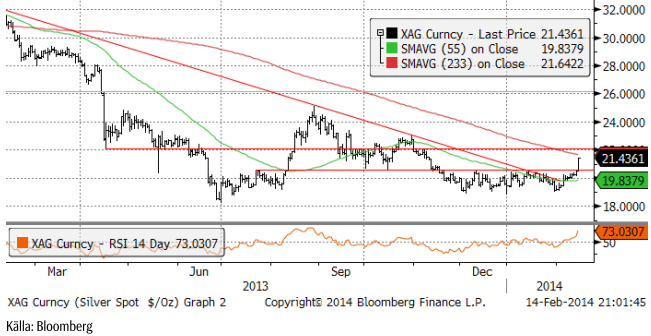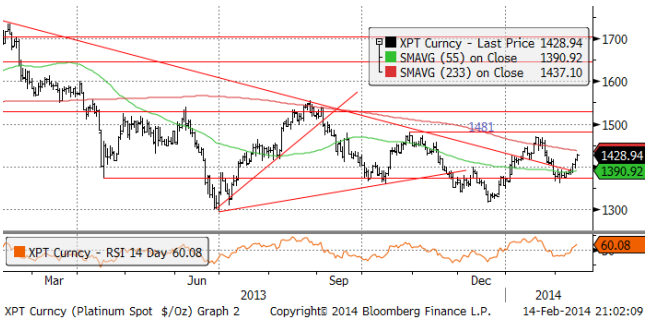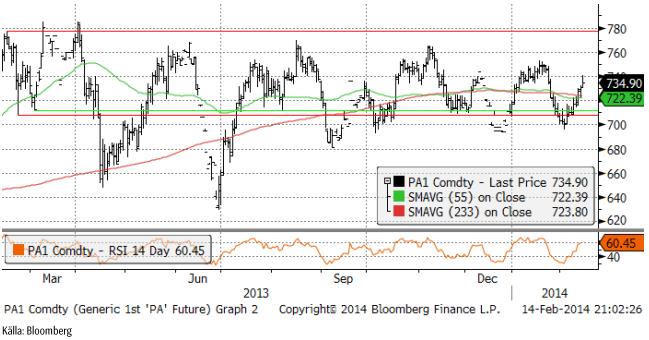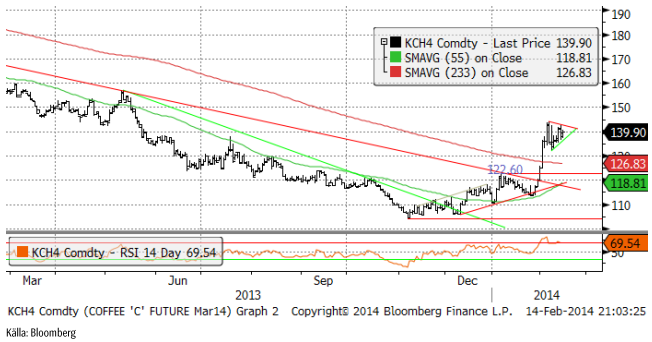Analys
SEB – Råvarukommentarer, 17 februari 2014
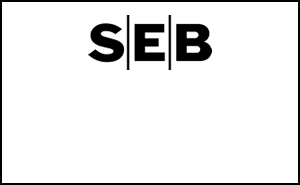
Rekommendationer
Råolja – Brent
Oljepriset fick styrka i veckan av att El Sharara-fältet i Libyen fick stängas igen. Marknaden har till viss del räknat in att Iran och Libyen ökar sin produktion i år. Gör de det, så faller priset. Gör de inte det, så stiger priset. Stängningen av El Sharara var alltså inte positiv ur den aspekten.
Kinas import av råolja var på rekordnivå i januari (liksom importstatistiken var för en rad råvaror).
Tekniskt är det möjligt att den konsolidering av priset vi sett efter uppgången från 106 dollar till 109 är en så kallad ”vimpel”. Om det är det, ska vi vänta oss ett utbrott på uppsidan, som har potential att ta priset till 111 dollar.
Fundamentalt genomgår oljemarknaden ett paradigmskifte där fracking radikalt ökar utbudet av råolja och minskar OPEC:s monopolställning. På längre sikt är det svårt att se något annat än ett stort prisfall på olja och vi vill handla oljemarknaden från den korta sidan. Tekniskt och i det mycket korta perspektivet av en vecka är det dock inte uteslutet, rentav troligt, att priset bryter upp och testar den övre delen av det ”gamla” prisintervallet. Med den reservationen behåller vi säljrekommendation, men rekommenderar inte att man går in i nya korta positioner på den här nivån, utan avvaktar bättre säljtillfällen.
Elektricitet
Elpriset bröt bröt stödet på 28.50 i fredags, vilket innebär att marknaden säger att skyddet mot ytterligare nedgångar har brutits. Det innebär att marknaden med hög sannolikhet kommer att handla ner priset ytterligare. Samtidigt är priset på en mycket låg nivå, som vi ser nedan.
Det är omöjligt att säga var botten är. Det lägsta priset på Q2-kontraktet år 2007 var 25.8 euro per MWh, som vi ser i nedanstående diagram över det vid var tid kortaste Q2-kontraktets pris.
I diagrammet nedan ser vi prisutvecklingen på Q2-kontrakten under det första kvartalet varje år sedan 2006. Det andra kvartalets kontrakt är på den lägsta nivån sedan åtminstone 2006. I diagrammet nedan ser vi prisutvecklingen på Q2 2014 som den vita kurvan och Q2 2007 som den blå kurvan. Som vi ser, ser prisutvecklingen i år ut att röra sig snarlikt prisutvecklingen under 2007 sedan början av året. Om detta fortsätter kommer prisnedgången att fortsätta.
Prognosen för hydrologisk balans är enligt Markedskraft mer eller mindre oförändrad från förra veckan. Vädret i Norden är dock milt och nederbördsrikt just nu.
Terminspriset för leverans av kol nästa år har fallit från 87 dollar till 82.30. Priset är alltså tillbaka på bottennivåerna från oktober. Priset ligger under produktionskostnaden för gruvorna i Australien, Sydamerika och Kanada. Den australiensiska dollar har under samma period fallit med 8% mot US-dollarn, så där är en av förklaringarna till varför kolpriset inte har stigit i US-dollartermer. Som vi ser handlade kolpriset upp i fredags. Kanske är det en vändning?
Risken är stor att de stora kollagren (”kolhögar överallt”) i Europa och det milda vädret i Norden fortsätter att påverka elpriset nedåt resten av vårvintern. Tekniskt är stödet vid 28.50 brutet, vilket är en signal att ta stoppar. Rekommendationen kan inte bli annat än neutral som högst just nu. Man ska dock vara observant på om priset går tillbaka över 28.50 euro per MWh, med tanke på att priset är på absoluta bottennivåer i ett historiskt perspektiv.
Naturgas
Det har fortsatt att vara kallt i USA, men nu börjar man se en omsvängning. Naturgaspriset har faktiskt backat lite från förra veckans 4.60 till 4.52 i fredags.
Basmetaller
Vi har en mer eller mindre positiv pristrend i basmetallerna som helhet, men med svag tendens sedan början av året. Den nedgången ”borde” vara nära sitt slut (eller inte). Den väntade optimismen efter det kinesiska nyåret har inte infunnit sig. Marknadens aktörer väntar fortfarande på ny information om tillståndet i den kinesiska efterfrågan. En pusselbit delades ut den här veckan. Januari månads importstatistik visade ovanligt hög import (+10%) och export (+10.6%). Importen intresserar naturligtvis råvarumarknaden mest. Importen av koppar och järnmalm nådde rekordnivåer. Marknaden blev dock inte fullt så imponerad, eftersom den höga importen hänger ihop med årsskifteseffekter. Som vanligt byggs det lager innan året och en del tyder på att varor har bokats och registrerats tidigare, men levereras på det nya året. Det finns en klar risk att februari-statistiken inte kommer att vara lika imponerande. Marknaden behöver se februaristatstiken för att få ökat förtroende.
Från ett tradingperspektiv, föredrar vi fortfarande att handla nickel som om den var inom ett prisintervall, och inte i en trend, även om vi favoriserar den långa sidan mer än den korta.
Koppar
Som du kunnat läsa i inledningen till basmetallsegmentet här ovan, är vi lite oroade för kopparmarknaden. Risken för ökat utbud i kombination med skuldproblemen i Kina och risken för bankrutter inom den svarta banksektorn där, utgör en klar risk för nedsidan i kopparpriset. Just nu ser det dock inte ut att ske, i närtid i alla fall. Marknaden visar stark efterfrågan med backwardation i terminskurvan. Kinas import är extremt stark. Dessutom är vi just nu i de säsongsmässigt starka första och andra kvartalen. Vi skulle inte bli förvånade om kopparpriset testar de senaste toppnoteringarna någon gång de kommande månaderna.
Ur ett tradingperspektiv, gör osäkerheterna att vi inte vill ta någon position i metallen just nu. I vår fundamentala prognos för det genomsnittliga priset för året (7450), väntar vi oss en stark marknad under det första halvåret, sedan att priset handlar svagare i Q3 och med en möjlig återhämtning under Q4.
Vi rekommenderar neutral position i koppar.
Aluminium
Aluminium har handlat starkare sedan priset noterade femårslägsta den 3 februari vid 1671 dollar. Det är alltid riskabelt att vara kort råvaror som handlar så långt ner i förhållande till produktionskostnaden. Den fundamentala balansen visar äntligen på konstruktiva tendenser. Som väntat har blankarna börjat köpa tillbaka positioner.
Konsumenter har varit på köpsidan. De tar tillvara varje prisnedgång för att köpa ytterligare hedgar. Sammantaget har detta tagit tillbaka priset till den ”gamla” tekniska stödnivån vid ca 1750 dollar. Premierna i den amerikanska marknaden har planat ut vid de extrema nivåer kring 440 dollar per ton. Enligt våra källor i den fysiska marknaden skeppas nu aluminium från Mellanöstern till USA för att dra fördel av de höga premierna. CME har startat ett nytt terminskontrakt på den fysiska premien och det visar redan snabbt ökande öppen balans. LME planerar fortfarande att introducera ett kontrakt. De nya LME-reglerna för lagerhanteringen kommer på lite längre sikt att dämpa premierna. En annan effekt av den höga premien är att finansieringsaffärer inte rullas framåt, när contangot mellan cash + premium till termin (utan premium) på LME inte ger tillräckligt avans. Risken för högre räntor i och med att FED har inlett tapering och att klockan tickar för nästa räntehöjningscykel påverkar sannolikt också.
I vilket fall, finns ett behov för ytterligare minskning i produktionen av aluminium. Så länge detta inte materialiseras, finns risken att aluminiummarknaden går in i överskott igen, om vi inte får se starkare efterfrågan än förväntat.
Vi fortsätter med neutral rekommendation på aluminium.
Zink
Zink har gjort imponerande vinster de senaste veckorna. Samtidigt, som vi noterade för ett par veckor sedan, har styrkan mattats av oron i tillväxtländerna. Terminsmarknaden handlar fortfarande cash till 3-månaders på samma nivå och längre kontrakt med ett litet contango. Givet att balanserna på längre sikt förbättras från 2015 och framåt, tycker vi att kurvan är ganska billig.
Vi rekommenderar köp av ZINK S eller BULL ZINK X4 S.
Nickel
Nickel handlar mitt i prisintervallet, vid 14,200 dollar. Det återspeglar osäkerheten kring det indonesiska exportförbudet. Marknadens aktörer drar sig för att ta positioner i avvaktan på nyheter från den indonesiska regeringen. Värt att notera är att priset på nickelmalm från Malaysia, som delvis är ett alternativ för NPI-producenter, har gått upp i pris. Malm inom Kina blir också dyrare. Scenariot vi beskrivit tidigare för nickel är i stort sett fortfarande relevant och innebär att det finns en begränsad nedsida i nickelpriset. Risken är på uppsidan för resten av året.
Guld
Det är nu tydligt att guld verkligen noterade en botten vid 1200 dollar per uns. Fredagens handel var haussartad. Det är dock vanligt att det sista man ser av en prisuppgång i guld är en ”spik” av det slaget. Det känns inte rätt att så här sent i en uppgång som pågått i två månader, gå in och köpa. Vi tycker det är bättre att avvakta den rekyl som brukar följa.
ETF-statistiken visar infllöden i silver-ETF:er (svart kurva) men inte lika tydligt i ETF-er på guld (gul kurva).
Vi fortsätter tills vidare med neutral vy på guld.
Silver
Silver bröt motståndet i fredags och steg kraftigt. Prisrörelsen var mycket snabb och priset är nu nästan uppe vid nästa motstånd, vilket gör att det är för sent att rekommendera köp.
Vi fortsätter med neutral vy på silver.
Platina & Palladium
Platina, trots sin mycket lugnare utveckling än både guld och silver, har ett marknadsbeteende som i början av en trendvändning uppåt. Rekylen nedåt efter uppgången i början på året stannade på en högre nivå än botten i december. Det är ett positivt tecken. Trendlinjen för den fallande pristrenden bröts i början av januari. Även om det skulle komma en liten rekyl nedåt nu, skulle det inte förändra bilden av att en större trendvändning är på gång.
Palladium, där prisuppgången varit snabb seden botten för ett par veckor sedan, mötte säljare i fredags, vilket fick priset att stänga långt under dagens högsta notering. Palladium är alltså fortsatt ”cappad” på uppsidan och eftersom priset redan är ”högt” inom intervallet, rekommenderar vi neutral position.
Vi rekommenderar alltså köp av både platina och neutral i palladium.
Kaffe
Det har varit skyfall i Sao Paulo de senaste dagarna. Regnvädret rör sig norrut mot kaffeodlingarna i Minas Gerais. Prisuppgången stannade vid en nivå kring 140 cent per pund när väderleksprognoserna visade att regnvädret faktiskt var på väg norrut. Tekniskt har priset bildat en ”vimpel” vid 140 cent och en sådan formation brukar följas av antingen ett brott uppåt (mot 160 cent) eller ett fall tillbaka. Marknaden försöker nu som bäst få grepp om vad den långsiktiga effekten av torkan är på kaffeskörden i Brasilien. Det är möjligt att man kommer fram till att minskningen i skörd de kommande åren är så stor att priset borde gå upp. Vi ska komma ihåg att USDA genom en survey under hösten räknat ut att den genomsnittliga produktionskostnaden i Brasilien är 147 cent. Priset på 140 cent idag är alltså inte så högt att det skulle locka så många kaffeodlare att expandera. Bortfallen produktion kanske inte ersätts. Det talar för en fortsatt prisuppgång.
Vietnam rapporterade att exporten i januari var 36% lägre än förra året.
Vi fortsätter med köprekommendation.
Det finns nu också mini futures på kaffe, som erbjuder högre hävstång. Se SEB-bankens utbud.
[box]SEB Veckobrev Veckans råvarukommentar är producerat av SEB Merchant Banking och publiceras i samarbete och med tillstånd på Råvarumarknaden.se[/box]
Disclaimer
The information in this document has been compiled by SEB Merchant Banking, a division within Skandinaviska Enskilda Banken AB (publ) (“SEB”).
Opinions contained in this report represent the bank’s present opinion only and are subject to change without notice. All information contained in this report has been compiled in good faith from sources believed to be reliable. However, no representation or warranty, expressed or implied, is made with respect to the completeness or accuracy of its contents and the information is not to be relied upon as authoritative. Anyone considering taking actions based upon the content of this document is urged to base his or her investment decisions upon such investigations as he or she deems necessary. This document is being provided as information only, and no specific actions are being solicited as a result of it; to the extent permitted by law, no liability whatsoever is accepted for any direct or consequential loss arising from use of this document or its contents.
About SEB
SEB is a public company incorporated in Stockholm, Sweden, with limited liability. It is a participant at major Nordic and other European Regulated Markets and Multilateral Trading Facilities (as well as some non-European equivalent markets) for trading in financial instruments, such as markets operated by NASDAQ OMX, NYSE Euronext, London Stock Exchange, Deutsche Börse, Swiss Exchanges, Turquoise and Chi-X. SEB is authorized and regulated by Finansinspektionen in Sweden; it is authorized and subject to limited regulation by the Financial Services Authority for the conduct of designated investment business in the UK, and is subject to the provisions of relevant regulators in all other jurisdictions where SEB conducts operations. SEB Merchant Banking. All rights reserved.
Analys
Tightening fundamentals – bullish inventories from DOE

The latest weekly report from the US DOE showed a substantial drawdown across key petroleum categories, adding more upside potential to the fundamental picture.

Commercial crude inventories (excl. SPR) fell by 5.8 million barrels, bringing total inventories down to 415.1 million barrels. Now sitting 11% below the five-year seasonal norm and placed in the lowest 2015-2022 range (see picture below).
Product inventories also tightened further last week. Gasoline inventories declined by 2.1 million barrels, with reductions seen in both finished gasoline and blending components. Current gasoline levels are about 3% below the five-year average for this time of year.
Among products, the most notable move came in diesel, where inventories dropped by almost 4.1 million barrels, deepening the deficit to around 20% below seasonal norms – continuing to underscore the persistent supply tightness in diesel markets.
The only area of inventory growth was in propane/propylene, which posted a significant 5.1-million-barrel build and now stands 9% above the five-year average.
Total commercial petroleum inventories (crude plus refined products) declined by 4.2 million barrels on the week, reinforcing the overall tightening of US crude and products.


Analys
Bombs to ”ceasefire” in hours – Brent below $70

A classic case of “buy the rumor, sell the news” played out in oil markets, as Brent crude has dropped sharply – down nearly USD 10 per barrel since yesterday evening – following Iran’s retaliatory strike on a U.S. air base in Qatar. The immediate reaction was: “That was it?” The strike followed a carefully calibrated, non-escalatory playbook, avoiding direct threats to energy infrastructure or disruption of shipping through the Strait of Hormuz – thus calming worst-case fears.

After Monday morning’s sharp spike to USD 81.4 per barrel, triggered by the U.S. bombing of Iranian nuclear facilities, oil prices drifted sideways in anticipation of a potential Iranian response. That response came with advance warning and caused limited physical damage. Early this morning, both the U.S. President and Iranian state media announced a ceasefire, effectively placing a lid on the immediate conflict risk – at least for now.
As a result, Brent crude has now fallen by a total of USD 12 from Monday’s peak, currently trading around USD 69 per barrel.
Looking beyond geopolitics, the market will now shift its focus to the upcoming OPEC+ meeting in early July. Saudi Arabia’s decision to increase output earlier this year – despite falling prices – has drawn renewed attention considering recent developments. Some suggest this was a response to U.S. pressure to offset potential Iranian supply losses.
However, consensus is that the move was driven more by internal OPEC+ dynamics. After years of curbing production to support prices, Riyadh had grown frustrated with quota-busting by several members (notably Kazakhstan). With Saudi Arabia cutting up to 2 million barrels per day – roughly 2% of global supply – returns were diminishing, and the risk of losing market share was rising. The production increase is widely seen as an effort to reassert leadership and restore discipline within the group.
That said, the FT recently stated that, the Saudis remain wary of past missteps. In 2018, Riyadh ramped up output at Trump’s request ahead of Iran sanctions, only to see prices collapse when the U.S. granted broad waivers – triggering oversupply. Officials have reportedly made it clear they don’t intend to repeat that mistake.
The recent visit by President Trump to Saudi Arabia, which included agreements on AI, defense, and nuclear cooperation, suggests a broader strategic alignment. This has fueled speculation about a quiet “pump-for-politics” deal behind recent production moves.
Looking ahead, oil prices have now retraced the entire rally sparked by the June 13 Israel–Iran escalation. This retreat provides more political and policy space for both the U.S. and Saudi Arabia. Specifically, it makes it easier for Riyadh to scale back its three recent production hikes of 411,000 barrels each, potentially returning to more moderate increases of 137,000 barrels for August and September.
In short: with no major loss of Iranian supply to the market, OPEC+ – led by Saudi Arabia – no longer needs to compensate for a disruption that hasn’t materialized, especially not to please the U.S. at the cost of its own market strategy. As the Saudis themselves have signaled, they are unlikely to repeat previous mistakes.
Conclusion: With Brent now in the high USD 60s, buying oil looks fundamentally justified. The geopolitical premium has deflated, but tensions between Israel and Iran remain unresolved – and the risk of missteps and renewed escalation still lingers. In fact, even this morning, reports have emerged of renewed missile fire despite the declared “truce.” The path forward may be calmer – but it is far from stable.
Analys
A muted price reaction. Market looks relaxed, but it is still on edge waiting for what Iran will do

Brent crossed the 80-line this morning but quickly fell back assigning limited probability for Iran choosing to close the Strait of Hormuz. Brent traded in a range of USD 70.56 – 79.04/b last week as the market fluctuated between ”Iran wants a deal” and ”US is about to attack Iran”. At the end of the week though, Donald Trump managed to convince markets (and probably also Iran) that he would make a decision within two weeks. I.e. no imminent attack. Previously when when he has talked about ”making a decision within two weeks” he has often ended up doing nothing in the end. The oil market relaxed as a result and the week ended at USD 77.01/b which is just USD 6/b above the year to date average of USD 71/b.

Brent jumped to USD 81.4/b this morning, the highest since mid-January, but then quickly fell back to a current price of USD 78.2/b which is only up 1.5% versus the close on Friday. As such the market is pricing a fairly low probability that Iran will actually close the Strait of Hormuz. Probably because it will hurt Iranian oil exports as well as the global oil market.
It was however all smoke and mirrors. Deception. The US attacked Iran on Saturday. The attack involved 125 warplanes, submarines and surface warships and 14 bunker buster bombs were dropped on Iranian nuclear sites including Fordow, Natanz and Isfahan. In response the Iranian Parliament voted in support of closing the Strait of Hormuz where some 17 mb of crude and products is transported to the global market every day plus significant volumes of LNG. This is however merely an advise to the Supreme leader Ayatollah Ali Khamenei and the Supreme National Security Council which sits with the final and actual decision.
No supply of oil is lost yet. It is about the risk of Iran closing the Strait of Hormuz or not. So far not a single drop of oil supply has been lost to the global market. The price at the moment is all about the assessed risk of loss of supply. Will Iran choose to choke of the Strait of Hormuz or not? That is the big question. It would be painful for US consumers, for Donald Trump’s voter base, for the global economy but also for Iran and its population which relies on oil exports and income from selling oil out of that Strait as well. As such it is not a no-brainer choice for Iran to close the Strait for oil exports. And looking at the il price this morning it is clear that the oil market doesn’t assign a very high probability of it happening. It is however probably well within the capability of Iran to close the Strait off with rockets, mines, air-drones and possibly sea-drones. Just look at how Ukraine has been able to control and damage the Russian Black Sea fleet.
What to do about the highly enriched uranium which has gone missing? While the US and Israel can celebrate their destruction of Iranian nuclear facilities they are also scratching their heads over what to do with the lost Iranian nuclear material. Iran had 408 kg of highly enriched uranium (IAEA). Almost weapons grade. Enough for some 10 nuclear warheads. It seems to have been transported out of Fordow before the attack this weekend.
The market is still on edge. USD 80-something/b seems sensible while we wait. The oil market reaction to this weekend’s events is very muted so far. The market is still on edge awaiting what Iran will do. Because Iran will do something. But what and when? An oil price of 80-something seems like a sensible level until something do happen.
-

 Nyheter3 veckor sedan
Nyheter3 veckor sedanStor uppsida i Lappland Guldprospekterings aktie enligt analys
-

 Nyheter4 veckor sedan
Nyheter4 veckor sedanBrookfield ska bygga ett AI-datacenter på hela 750 MW i Strängnäs
-
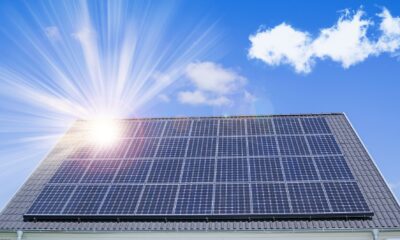
 Nyheter4 veckor sedan
Nyheter4 veckor sedanSommaren inleds med sol och varierande elpriser
-
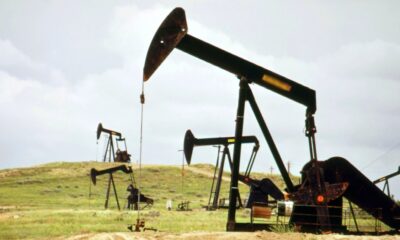
 Nyheter4 veckor sedan
Nyheter4 veckor sedanOPEC+ ökar oljeproduktionen trots fallande priser
-

 Nyheter3 veckor sedan
Nyheter3 veckor sedanSilverpriset släpar efter guldets utveckling, har mer uppsida
-

 Analys4 veckor sedan
Analys4 veckor sedanBrent needs to fall to USD 58/b to make cheating unprofitable for Kazakhstan
-
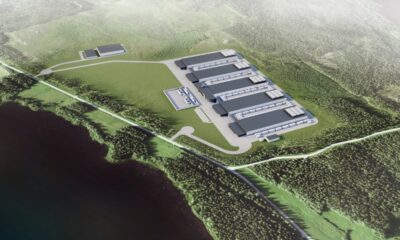
 Nyheter4 veckor sedan
Nyheter4 veckor sedanTradingfirman XTX Markets bygger datacenter i finska Kajana för 1 miljard euro
-

 Nyheter2 veckor sedan
Nyheter2 veckor sedanUppgången i oljepriset planade ut under helgen


